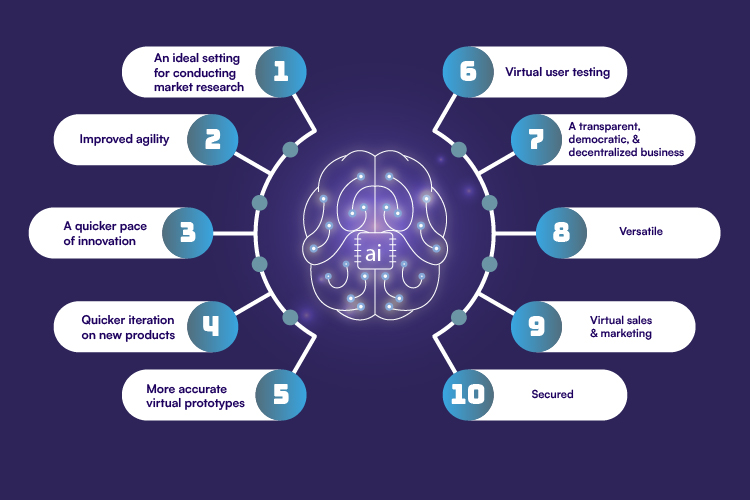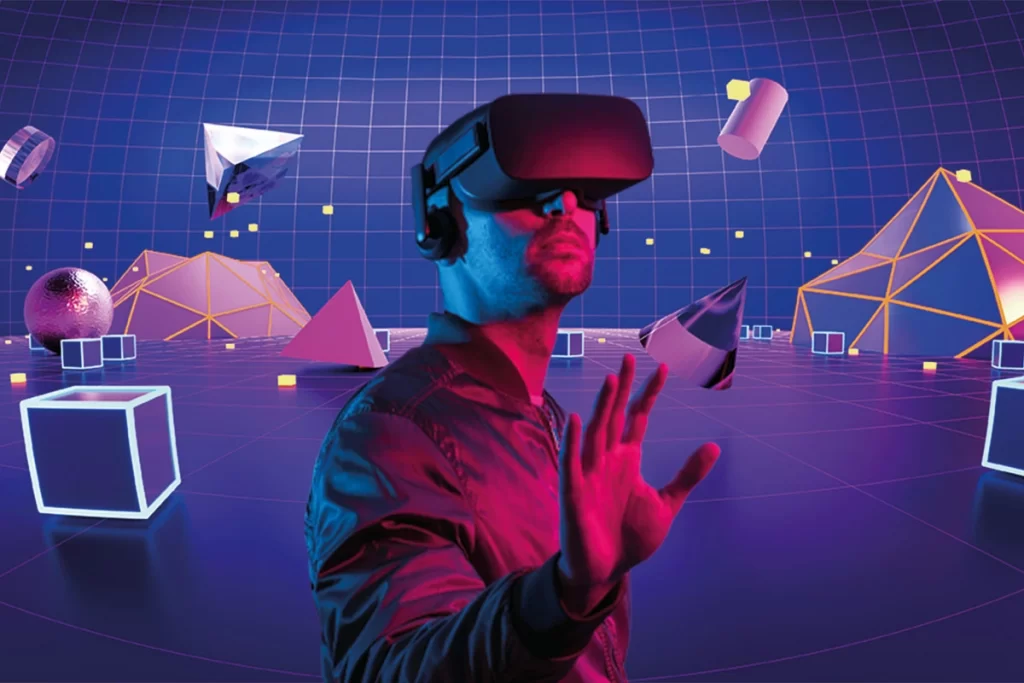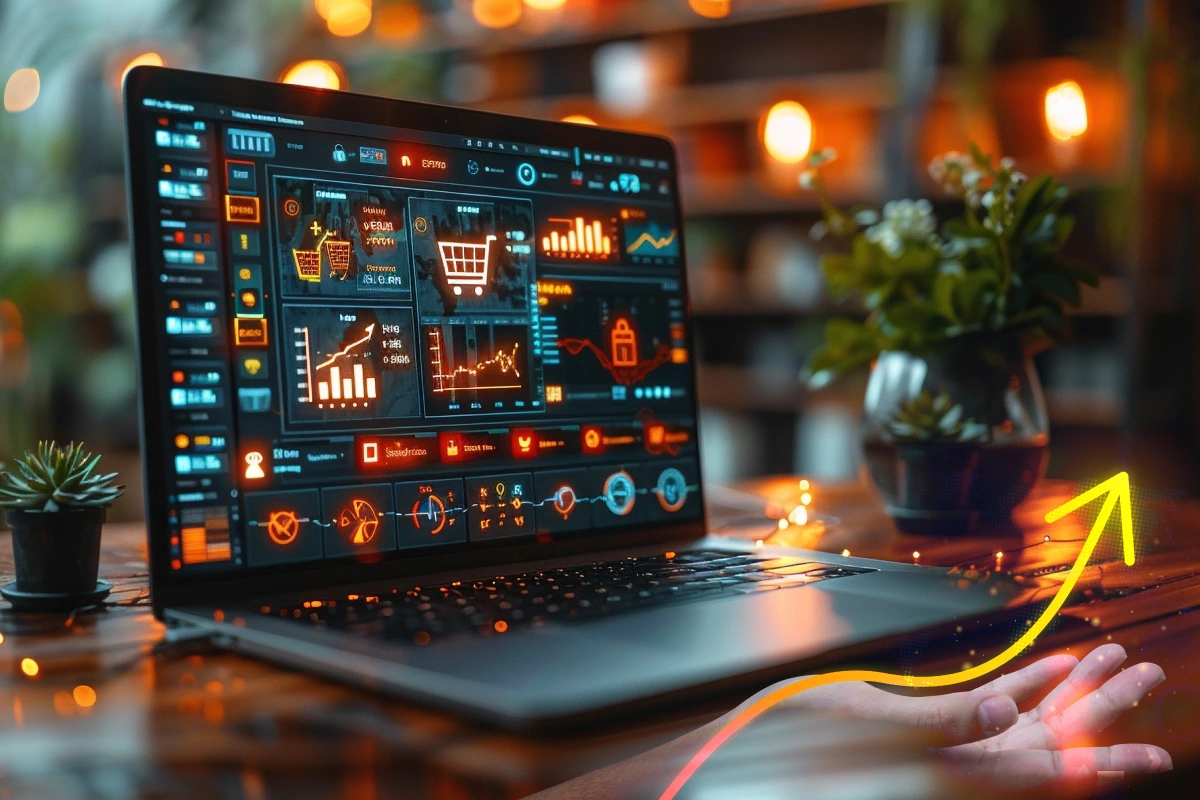The future of metaverse in product development has been increasingly integrating itself into our daily lives. Teleporting daily life into a digital realm, this virtual, immersive, and interactive universe seeks to transform mundane tasks into exciting new adventures. Anyway, the future of Metaverse has significant implications for product development as we navigate the ever-changing worlds of virtual reality and interconnected digital spaces.
The concept of the “Metaverse” refers to the merging of many virtual environments into a single, persistent, online 3D universe. To be more specific we say it’s a combination of Blockchain, Augmented Reality (AR), Virtual Reality (VR) and other technologies that provide an engaging and interconnected experience. The Metaverse has special features that let people meet, play games, work, and socialize in 3D places. Similar to how different websites can be browsed from the same browser, the concept encompasses the merging of many platforms.
The Metaverse Market is set to witness a transformative journey on the global scale, with a projected escalation from USD 61.8 billion in 2022 to a significant USD 426.9 billion by 2027. This substantial growth is driven by an impressive Compound Annual Growth Rate (CAGR) of 47.2%.
source:GlobeNewswire
Isn’t this a fascinating number? However, we’d like to highlight a few more fascinating aspects of this emerging technology that will shape the course of product development in the future.
Metaverse Trends 2024 is a revolutionary approach to developing products that boost productivity and open up exciting possibilities in the world of digitization. It significantly impacts the future of product development since it aims to take human-digital interaction to the next level.
So what exactly is Metaverse?
Neal Stephenson coined the term “Metaverse” in his 1992 science fiction novel “Snow Crash,” in which he depicted a world in which lifelike avatars encountered one another in realistic 3D buildings and other virtual reality situations.
In the years afterwards, many advances have paved the way for the realization of the Metaverse. An online virtual world that combines various forms of augmented & VR. As well as, virtual worlds with 3D holographic avatars, video, and other forms of communication. As the metaverse technical revolution grows, it will provide a hyper-real alternative reality where you and other people can live together.
The Metaverse is an AR platform where users control their own individual avatars. Take, for instance, the option to hold a virtual reality meeting in your digital office. After that, you can unwind with a game built on the blockchain. Beyond that, you can handle your cryptocurrency holdings and finances without ever leaving the Metaverse. As a result of the introduction and influence of these technologies, society is changing to spend more time in the hyperreal world.
Artificial intelligence, VR and AR are currently the technologies with the most resources and development. They will also collaborate in a Metaverse that will soon unify all small platforms into a single, seamless virtual environment that is identical and transcends the real world in numerous ways.
Currently, the metaverse is the hottest thing in the world of 3D social media platforms, blockchain-based marketplaces and crypto-based technology. Web 3.0 has been heralded by many as the start of a brand new period for the World Wide Web. Businesses can make use of several aspects of the metaverse that are poorly understood by the general public.
As a starting point, know that the idea implies a higher degree of digital immersion in our daily lives. We shall no longer use traditional online browsers, but rather, digital worlds populated by avatars. Companies are already preparing for the metaverse, and one area in particular, product development services, is about to undergo a radical transformation. A key point is that Metaverse digital technology has attracted leading global brands looking for new ways to expand their brand, reach new customers and increase customer loyalty.
The Impact of the Metaverse on Product Development
The widespread adoption of product development in the Metaverse will not render obsolete the numerous digital assets already in widespread use. However, this improved version of the metaverse product Development trend will have significant ramifications for digital products. Metaverse’s immersive experience will shape the way products are made in the future, which is good news for consumers and companies alike.
Metaverse design and development must take into account the practical concerns of designers and developers. A digital product’s design and development team needs to re-evaluate its approach and the technologies it plans to use during development. These developers use various tools and technologies to create immersive experiences. From blockchain integration to 3D modelling software, these tools are essential to Metaverse product development. To improve the purchase journey for customers and consumers, they must adjust their function and adopt a new approach based on brainstorming sessions.
To deliver an enhanced experience for their customers, businesses should be aware of what’s coming in the digital world and encourage their development and design teams to experiment. For instance, if you’re in charge of an online gaming store, you should always be aware of what’s happening in the sector and prepared to adapt.
After reading this brief overview of the Metaverse, it’s time to examine the current and future directions in product creation inside the Metaverse.
Present Day in the Metaverse
The current state of the metaverse, which consists mainly of augmented and virtual reality applications, is not meant to replace human interaction but rather to improve it. There are exciting new ways for product developers to interact with their teams and consumers in the metaverse.
A “metaverse” is a viewable and explorable online virtual world. In the realm of product development, a metaverse can be used to construct digital prototypes of products and put them through their paces in a virtual environment before they are made physically. Saving both time and money can result from discovering and resolving design flaws early on in the development process. In addition, a metaverse can be used to create convincing and engaging product demos that allow clients to test goods in a risk-free virtual environment. The result may be increased demand and a greater number of purchases. These examples clearly demonstrate that the metaverse is an environment where almost anything is possible and more accessible than the physical world.
If take an example; more than 25 years ago, Ford Motor Company began integrating virtual reality (VR) technology in the design and testing of their vehicles. Ford established a VR lab at its Dearborn, Michigan, headquarters in 2016 to build and test digital prototypes of future automobiles. This facilitates faster problem detection and resolution by designers and engineers and permits them to make better decisions regarding design enhancements. In addition, Ford employs virtual reality (VR) technology to create exciting and instructive product demonstrations for customers. Ford’s use of the metaverse has improved the efficiency of its design and testing processes, increased the number of people interested in their cars, and piqued their interest.
It’s no secret that most profitable companies are adopting Metaverse technology to improve their business. In the era of digital transformation, Nike is leveraging the metaverse to create virtual product presentations, giving buyers a chance to try out the company’s wares in a safe, risk-free, and immersive online setting. Nike has acquired NFT fashion startup RTFKT with an aim to sell Nike shoes on Metaverse. Similarly, Gucci recently hosted its own Gucci Vault Land in the Sandbox metaverse

Metaverse in the Future
With the advent of the Metaverse future trend, users will be able to interact in a shared virtual environment that closely mimics the actual world. In today’s Internet, every company and next-gen product has its own website. Finding what you’re looking for requires a search followed by a selection of goods from the store of your choosing. The metaverse of the future will function as a large marketplace.
Wearing virtual reality headsets, customers will join a massive virtual market and examine merchandise in a fully immersive third dimension. All of the users’ wares will be in one convenient online location. The future of the metaverse has many commercial opportunities.
Advantages of Emerging Trends in the Metaverse

Even if the metaverse won’t reach full maturity until 2030, tech companies need to start considering the possibilities now.
Designers and developers of products need to stay abreast of emerging technologies and industry trends or risk seeing their expertise rendered obsolete.
By putting new metaverse technologies through their paces early on, they can come up with ideas that haven’t occurred to other designers or developers. Each of the prominent product design companies actively promotes new ideas. The ability to engage with users on a personal level is transforming marketing in the metaverse.
By 2026, Gartner projects that 25% of the global population will spend at least one hour every day in the metaverse for activities like jobs, trade, education, and entertainment.

1. An Ideal Setting for Conducting Market Research
The comprehensive environment of the metaverse makes it possible for businesses to learn about their customers’ wants and needs and use that information to shape future product development. Brands can also incentivize their most valuable customers by giving them early access to prototypes of new products, or they can monetize the innovation process by charging members for access. A few examples include trying out home appliances with 3-D printed meals and robotic features.
2. Improved Agility
Any changes made to a product’s design in a metaverse will be reflected instantly in the virtual environment. This will allow for more rapid iteration of designs and quicker reaction times. Nowadays businesses are looking for ways to sell virtual goods and services, including digital real estate, games, and virtual fashion.
3. A Quicker Pace of Innovation
The metaverse has the potential to revolutionize IT industry by hastening the prototyping phase. This has the potential to inspire process and innovation in product design, resulting in expanded consumer choice and reduced development times.
Per se, imagine a web meeting in which everyone is represented by an avatar that conveys their expressions and body language, where everyone’s screens are shared simultaneously, and where 3D digital assets can be brought in as needed, rather than the typical Web meeting (e.g., Teams, Zoom) where everyone is on camera and where each participant can only share their screen one at a time.
4. Quicker Iteration on New Products
Using a metaverse creative collaboration, companies will be able to create digital prototypes of products and put them through their paces in a simulated environment before committing to a physical production run. Finding and resolving design flaws early on in the development process will reduce costs and development time.
5. More Accurate Virtual Prototypes
We have access to a plethora of tools that allow us to create high-quality mock-ups and designs for products. And thus, the current product development cycle operates at a high level of effectiveness. People today utilize SAAS whiteboards and other similar tools to sketch out elaborate digital prototypes of future products.
The metaverse will transform these images into three dimensions. Because virtual reality (VR) and augmented reality (AR) are so integral to the metaverse, we may expect to see designers create interactive 3D virtual models that users can rotate and examine from all sides. It enables designs to produce more reliable prototypes and finished goods.
6. Virtual User Testing
Innovative user testing of software is made possible by metaverse technology. It should be noted that usability testing is crucial in the design of user-centred virtual environments. Users of the Metaverse can experience a realistic simulation of the actual world. This allows customers to give input on the software’s usability and functioning in a setting that is as near as possible to actual use. This sort of testing yields valuable information that may be applied to the development of a better software product.
7. A Transparent, Democratic, and Decentralized Business
The business community may become more democratic, decentralized virtual environment, and transparent as a result of the metaverse. Products designed entirely in digital form necessitate separate production methods and teams that can operate on a global scale.
Customers could monitor the production of their products from the procurement of raw materials to delivery, resulting in a greater demand for ethical business practices.
Product development teams have always benefited from effective communication and cooperation, and the metaverse makes it possible to hold meetings with fewer people present without losing the benefits of body language and emotion. Many VR programs are designed to accommodate multiple users, thus cooperative endeavours are still viable. As a result, businesses are becoming more innovative and able to bring together teams from all over the world with less difficulty and expense.
8. Versatility
Web page design and development would be afforded greater room to breathe in the Metaverse. Since VR is an entirely 3D setting, it may be used by businesses to examine product designs from every vantage point. This suggests a wide variety of strategies for developing and evaluating the product. Companies and content producers will benefit from this leeway in their ability to innovate.
9. Virtual Sales and Marketing
Marketing and promoting software can find a new home in the Metaverse. Companies may now construct dynamic and immersive virtual environments to demonstrate their products. Additionally, products make use of the immersive nature of metaverse to develop interactive advertising campaigns and product placements. This type of advertising can be more interesting to consumers and can help them learn more about the benefits of the product.
10. Security
In the long run, the metaverse environment would make it easier and safer to build and maintain websites. Blockchain technology at its core will be important in making the internet safer for everyone. Developers would then be able to make safer versions of websites and apps. Safer data storage for users is another advantage of the Metaverse.
Conclusion
The Metaverse is an alternate reality of the future that incorporates the sensations of taste, smell, and touch into the whole experience. There are potential benefits for software product development and risks to human safety associated with these technologies. Innovations in the metaverse should be consistent with Web 3.0 because Web 3.0 is designed to fix the problems of Web 2.0.
Accelerated invention cycles, innovative and immersive product testing, decentralized production, and seamless interconnectivity between the digital and physical worlds are just a few ways in which the metaverse is poised to transform the production process.
By improving their software development processes, user experiences, and customer engagement, companies that adopt these technologies will have a leg up on the competition. It’s likely that buyers will have a major say in how things are created.
The ongoing development of the Metaverse’s asymmetrical components makes it possible for businesses to experience exponential growth and constant innovation at a large scale. The new digital world presents opportunities for collaboration, hypothesis creation, and ecosystem identification for a product development company.




